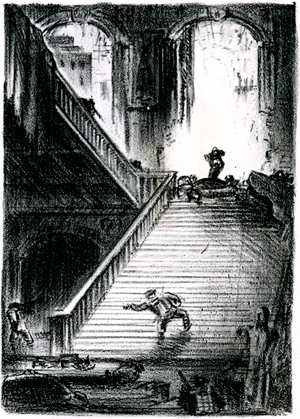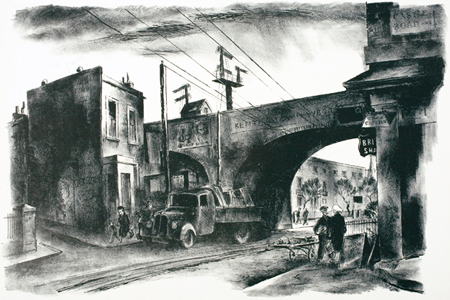Lithographs
In the early 20c, a lithograph was drawn on a hefty stone and couldn’t be printed without a litho press so lithographers didn’t work in attic flats but went instead to an art school and used their facilities and expertise. James Boswell did just that. Around 1929 he went to the Central School of Art in London and joined the evening class of A S Hartrick who was probably the best teacher of lithography anywhere. There, along with James Holland and James Fitton he honed his lithographic skills until the war got in the way.

His first lithographs were clearly discovering how to do it and were a bit bizarre. It wasn’t until 1930 that he began to do original drawings of his own, transferred to stone, sometimes with added colour. In 1933 he produced eight small lithographs, The Fall of London, possibly for a book which never happened – he was doing a lot of book jackets at the time. They illustrate London at a time of disaster, small images of the collapse of familiar buildings, looting, fighting, mayhem, seven years before it became a reality.
In 1934, Left Review appeared and The Three James, Boswell, Holland and Fitton, provided many illustrations for this literary, left wing magazine which was largely funded by the communist party. Their illustrations were lithographs. They were simple, savage, satirical comments on the politics of the day and they were quite unlike anything which had been seen in the UK for years. Many of these were drawn on stone and often multiple prints have survived. Between 1934 and 1940 Boswell produced over fifty lithographs, satirical, landscapes, town streets and the reality of life at the time - the misery caused by the means test and a murder in Gosfield Street plus the London in which he lived and which he loved and the people whom he saw around him.

He rarely ventured further afield than Camden Town, Kentish Town, Charlotte Street, Charing Cross Road and the City and if he couldn’t get to a place on foot, by local train, by bus or by trolleybus, he didn’t go there. He made his lithographs from drawings in his sketch books, faithful copies of his original and always in black and white. Sometimes the original was very small and several survive, neatly squared up for enlargement onto stone; London streets and London people and never far from home.
By 1940 the war made it impossible to appropriate the Central School of Art litho press, ARP duties and bombs got in the way and Boswell stopped. He did one more. His last lithograph, The Winning Side was published in 1951 as part of the third set of Prints for Schools to celebrate the Festival of Britain.
Sal Shuel




